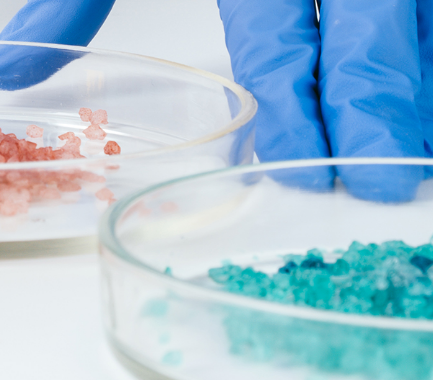Your contact
PENPET-Team - Hamburg

Christoph Meister
Sales
Tel. +49 (0) 40 - 675 7 99 30
sales@penpet.de
Get in touch with us.
Phenol
Phenol is an organic compound from the group of benzene derivatives which, as a starting material for the production of polymer plastics, is of great importance for the chemical industry. The substance is obtained from propene and benzene using the cumene hydroperoxide process.
Many plastics contain phenolic components. In the production of these materials, phenol is used directly or in processed form as a monomer and comonomer for polymerization processes. Among other things, hardened phenolic resins can be obtained from the phenolic resins that are produced on the basis of the compound. The substance is also an important starting material for synthetic processes in organic chemistry to obtain compounds such as caprolactam or bisphenol A. In the pharmaceutical industry, active ingredients such as the painkiller acetylsalicylic acid are manufactured on the basis of phenol.
At PENPET you get phenol of the highest quality, from a reliable partner who will also meet your requirements in the long term. We look forward to receiving your inquiry for an individual offer. The prompt delivery of the solid can be loose in iso containers or in drums with different weights.
CAS no. 108-95-2
EINECS no. 203-632-7
Molecular formula: C6H6O
Synonyms: Benzenol, benzeneol, benzophenol, phenyl alcohol, phenyl acid, phenyl hydrate, phenyl oxide hydrate, oxybenzene, monohydroxybenzene, hydroxybenzol, hydroxybenzene, carbolic acid, carbolic acid, carbol
Areas of application: Starting material for the production of polymer plastics, intermediate product for organic synthesis, basis for pharmaceutical active ingredients
More Information
As a benzene derivative, phenol is an aromatic compound. The substance consists of an unsaturated ring structure of six carbon atoms connected to a hydroxy group on one of the atoms. Thus, phenol has the functional group of the alcohols. However, most of the reactions that the substance undergoes are based on the substitution of hydrogen atoms in the ring structure by reactants.
Due to the clear electrical polarity of the hydroxy group, the centers of charge in the phenyl ring are shifted so much that the substance has a strong tendency towards electrophilic substitution. As a result, the compound is many times more reactive than benzene, which consists of only one aromatic ring.
Under normal conditions, phenol exists as a white solid in the form of crystalline needles. However, the compound already melts when heated to 41 °C. Liquid phenol boils at 182 °C. The substance has an aromatic odor. Weak solutions of the compound have a sweet taste.
Phenol is hygroscopic and attracts moisture, but is only moderately soluble in water. Conversely, there is also a limited solubility of water in liquid phenol, so that one can speak of a miscibility gap when the proportions are more balanced. However, the compound is very soluble in many organic solvents such as acetone, chloroform, diethyl ether, ethanol and glycerol. Phenol is a weak acid whose pH can range from 8 to 12 in aqueous solution.
Phenol is a very reactive compound. Violent, dangerous reactions can occur with bromine, aluminum, oxidizing agents, strong bases, strong acids, formaldehyde, benzaldehyde and hydrogen peroxide, among others. There is a risk of explosion on contact with aluminum chloride, nitrobenzene, formaldehyde, butadiene, peroxomonosulphuric acid and peroxodisulfuric acid.
Phenol is flammable but difficult to ignite. However, the vapors of the liquid compound can form easily flammable and explosive mixtures with the ambient air. Gases that are hazardous to health, such as carbon dioxide and carbon monoxide, are released when the substance is burned.
Phenol presents acute and chronic health hazards. On the skin, the compound first causes burning pain, then numbness, redness and paling of the contact point, as well as severe vascular damage. Affected parts of the body should be rinsed thoroughly with polyethylene glycol, ethanol and water. Medical treatment must then be arranged immediately. In addition to the symptoms described, phenol causes severe swelling of the eyelids, clouding of the cornea and severe inflammation of the iris and cornea. This can cause irreversible impairment of vision, and blindness is possible. After contact with the compound, the eye should be rinsed under running water as soon as possible. Immediate ophthalmological treatment is required to avoid irreversible damage.
Inhaling phenol can cause severe irritation in the nose and throat. This can result in swelling of the airways and damage to the lungs. Swallowing the compound can cause burning pain in the mucous membranes and chemical burns in the mouth, esophagus and stomach lining. In addition, gastrointestinal symptoms such as stomach pain, nausea, vomiting and diarrhea are to be expected. After rinsing the mouth, water should be carefully drunk to dilute the swallowed phenol.
The compound is rapidly absorbed into the metabolism. The symptoms of poisoning include cramps, sweating, headaches, hearing disorders, dizziness, cardiovascular disorders, signs of paralysis, unconsciousness and organ damage to the liver and kidneys. If high doses of phenol are ingested, life-threatening respiratory paralysis or cardiac dysfunction can occur after just a few minutes. Get medical help immediately to treat poisoning.
Phenol is considered to be a significantly water-polluting hazardous substance. The compound must not get into the ground, groundwater or bodies of water. In the event of leakage of the substance into the environment, the local authorities must be informed. The transportation of phenol is subject to special regulations.
